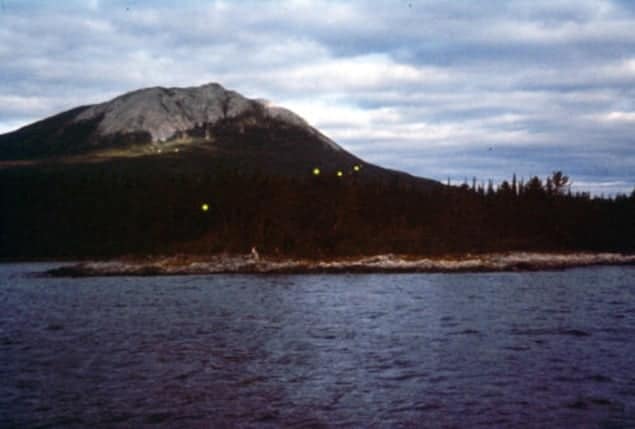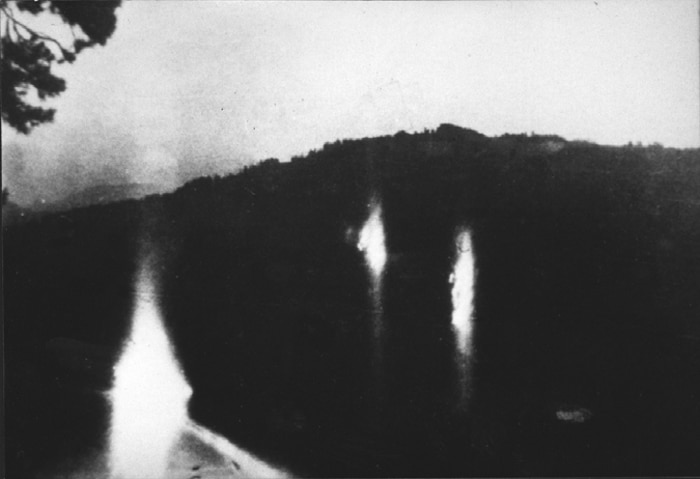
Earthquake lights – the rare, glowing phenomena that are occasionally seen before or during seismic events – may be closely associated with a specific type of geological fault. That is the conclusion of a new study by researchers in Canada and the US who have studied descriptions of the phenomenon that have been recorded over the past 400 years. The team suggests that the “subvertical” faults might act as channels that direct electrical charge to the surface, where it ionizes air to create the luminous effect.
The origins of earthquake lights have long been an intriguing mystery for seismologists and their existence was not confirmed until they were first captured on film in the 1960s. In this latest study, Robert Thériault of Quebec’s Ministry of Natural Resources and colleagues studied well-documented observations of the phenomena going back to the 1600s. To ensure only the best, authentic events were analysed, the team discarded reported luminosities with possible non-seismic origins. These included cases where the lights were accompanied by smoke issuing from the ground, or were suggestive of Moon or Sun halos. In total, the team included 65 events from the Americas and Europe in its study.
Among the sightings that were examined was a report of “streams of light” seen running along the ground 100 km north-west of San Francisco before the infamous 1906 earthquake, which destroyed 80% of the city. The study also includes the bright pink-purple globe of light that flew above Quebec’s St Lawrence River prior to the 1988 Saguenay earthquake.
Globes, illuminations and flames
The survey revealed that lights have occurred alongside earthquakes of a variety of magnitudes – between M 3.5 and 9.2. The majority (80%) were associated with earthquakes of magnitude greater than M 5.0, which corresponds to a medium-sized earthquake. The lights themselves also varied in shape and size. They have appeared as stationary or moving globes, atmospheric illuminations or in flame-like configurations issuing from the ground. Also variable was the distance from the earthquake epicentre to where the light was seen.
Unexpectedly, the team found that 97% of earthquake lights were associated with subvertical faults, which only cause about 5% of the Earth’s total seismic activity. Subvertical faults exist where a region of a tectonic plate is stretched, pulling it apart and causing faults in the form of vertical cracks – or rifts – to form in the crust. These “intraplate” regions are unlike the subduction zones that are associated with most earthquakes, where one plate is slipping below the other.

Another important finding of the study is that the lights only seem to happen before or during an earthquake. When lights appear prior to an earthquake, Thériault and colleagues believe this indicates a relation between the lights and the rapid build-up of stress deep underground prior to fault rupture. When lights and earthquakes occur at the same time, the team believes the phenomenon is related to changes in stress that occur as transverse shear waves propagate through the crust.
This second explanation is backed up by a recent event included in the study. During a 2007 earthquake in Pisco, Peru, security cameras captured lights forming in the air at the same time as shear waves passed through the ground below.
Positive-charge carriers
The team believes that the lights are caused by the stress-induced creation of mobile carriers of positive charge within metamorphic and igneous rocks. Existing defects in the rocks’ mineral structure – described chemically as peroxy bonds – break preferentially when stressed, forming positive charges that can move throughout the rock. These charges are then directed towards the surface by the vertical rift structure.
“Rift settings are characterized by deeply penetrating subvertical faults, which is not the case for subduction-zone-related tectonic environments,” explains Thériault. “We believe that deeply penetrating vertical-to-subvertical faults may help in ‘channelizing’ the electronic-charge carriers towards the surface.” In contrast, the shallow inclination (at 30–45%) of subduction-related faults – along with their tendency to occur under the ocean – is believed to prevent the light-generating charges from reaching the surface.
In the past, the portentous nature of earthquake lights has occasionally served as a useful warning. In Italy’s 2009 L’Aquila earthquake, for example, a resident led his family to safety outside after seeing flashes of light inside his home a few hours before the earthquake hit. This recognition of impending danger, however, seems to be rare in history. “Hopefully, the publication of our research will help the general public to know more about what earthquake lights are all about,” Thériault comments, adding that “public awareness that such phenomena exist and can be related to an upcoming earthquake may ultimately save lives.”
Monitoring network
The researchers are now looking into the possibility of establishing a monitoring network capable of earthquake forecasting. This would use studies of earthquake lights and other parameters that are known to vary prior to earthquake episodes. These include air ionization, the electrical conductivity of soil, and electromagnetic emissions. Some or all of these phenomena could also be related to stress-induced electric-charge generation.
While some experts have welcomed the study, others have expressed concerns about its methodology. “While less than 5% of the world’s earthquakes do occur in intraplate tectonic settings, such events often occur in inhabited areas and therefore the probability of any earthquake-related phenomena being humanly observed is probably high. This study appears to fail to take this sampling bias into account,” explains Mamoru Kato, a geophysicist from Kyoto University. Kato concludes that the paper, while good as a review of documented earthquake light events, could be premature in its conclusions.
The study is described in Seismological Research Letters.



